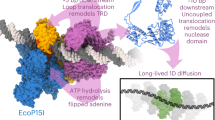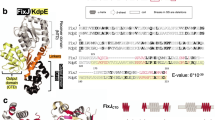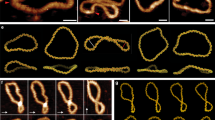Abstract
The structure of the TATA-box bound to the TATA-binding protein revealed a new and unexpected deformation of the double helix leading to a sharp change in the DNA trajectory. Here we show that the deformation imposed upon the TATA-box represents a novel form of the double helix—named TA-DNA—which differs from A-DNA by a single conformational parameter, namely the rotation around the glycosidic bond. This rotation causes a 50° inclination of the base pairs in the TATA-box which in turn results in abrupt change in the trajectory of the flanking B-DNA segments. The observation that the TATA sequence can assume an A-DNA conformation coupled to the simplicity of the transition from A-DNA to TA-DNA may be the reason for the presence of the TATA sequence in a wide range of promoters.
This is a preview of subscription content, access via your institution
Access options
Subscribe to this journal
Receive 12 print issues and online access
$259.00 per year
only $21.58 per issue
Buy this article
- Purchase on SpringerLink
- Instant access to full article PDF
Prices may be subject to local taxes which are calculated during checkout
Similar content being viewed by others
References
Shakked, Z. et al. Crystalline A-DNA: the X-ray analysis of the fragment d(G-G-T-A-T-A-C-C). Proc. R. Soc. Lond. B213, 479–487 (1981).
Shakked, Z. et al. Sequence-dependent conformation of an A-DNA double helix. The crystal structure of the octamer d(G-G-T-A-T-A-C-C). J. molec. Biol. 166, 183–201 (1983).
Dickerson, R.E. DNA structure from A to Z. In Methods in Enzymology, vol. 211, part A, DNA Structures (eds Lilley, D.M.J. & Dahlberg, J.E.), 67–111 (Academic Press, Inc., 1992).
Bingman, C., Jain, S., Zon, G. & Sundaralingam, M. Crystal and molecular structure of the alternating dodecamer d(GCGTACGTACGC) in the A-DNA form: comparison with the isomorphous non-alternating dodecamer d(CCGTACGTACGG). Nucleic Acids Res. 20, 6637–6647 (1992).
Weston, S.A., Lahm, A. & Suck, D. X-ray structure of the DNase I-d(GGTATACC)2 complex at 2.3 Å resolution. J. molec. Biol. 226, 1237–1256 (1992).
Lahm, A. & Suck, D. DNase I-induced DNA conformation. A structure of a DNase I-octamer complex. J. molec. Biol. 222, 645–667 (1991).
Kim, Y., Geiger, J.H., Hahn, S. & Sigler, P.B. Crystal structure of a yeast TBP/TATA-box complex. Nature 365, 512–520 (1993)
Kim, J.L., Nikolov, D.B. and Burley, S.K. Co-crystal structure of TBP recognizing the minor groove of a TATA element. Nature 365, 520–527 (1993).
Klug, A. Transcription. Opening the gateway. Nature 365, 486–487 (1993).
Shakked, Z. & Rabinovich, D. The effect of the base sequence on the fine structure of the DNA double helix. Prog. Biophys. molec. Biol. 47, 159–195 (1986).
Kim, J.L. & Burley, S.K. 1.9 Å resolution refined structure of TBP recognizing the minor groove of TATAAAAG. Nature struct. Biol. 1, 638–653 (1994).
Selsing, E., Wells, R.D., Alden, C.J. & Arnott, S. Bent DNA: visualization of a base-paired and stacked A-B conformational junction. J. biol. Chem. 254, 5417–5422 (1979).
Hegde, R.H., Grossman, S.R., Laimins, L.A. & Sigler, P.B. Crystal structure at 1.7 Å of the bovine papillomavirus-1 E2 DNA-binding domain bound to its DNA target. Nature, 359, 505–512 (1992).
Schultz, S.C., Shields, G.C. & Steitz, T.A. Crystal structure of a CAP-DNA complex: the DNA is bent by 90°. Science 253, 1001–1007 (1991).
Wu, H.-M. & Crothers, D.M. The locus of sequence-directed and protein-induced DNA binding. Nature, 308, 509–513 (1984).
Crothers, D.M., Haran, T.E. and Nadeau, J.G. Intrinsically bent DNA. J. biol. Chem. 256, 7093–7096 (1990).
Travers, A.A. and Klug, A. in DNA Topology and its Biological Effects (eds Cozzarelli, N.R. & Wang, J.C.) 57–106 (Cold Spring Harbor Laboratory Press, New York, 1990)
Shakked, Z. et al. Determinants of represser/operator recognition from the structure of the trp operator binding site. Nature 368, 469–473 (1994).
Shakked, Z. et al. Sequence-specific gene regulatory interactions: the role played by the structure and hydration of the DNA target. in Structural Biology: the State of the Art, vol. 1, (eds Sarma, R.H. & Sarma, M.H.) 199–216 (Adenine Press, New York, 1994).
Guzikevich-Guerstein, G., Ph. D. thesis (Submitted to the Feinberg Graduate School of the Weizmann Institute of Science, 1995).
Wobbe, C.R. & Struhl., K. Yeast and human TATA-binding proteins have nearly identical DNA sequence requirements for transcription in vitro. Molec. cell. Biol. 10, 3859–3867 (1990).
Hunter, C.A. Sequence-dependent DNA structure. The role of base- stacking interactions. J. molec. Biol. 248, 662–678 (1995).
Travers, A.A. Reading the minor groove. Nature struct. Biol. 2, 615–617 (1995)
Eisenstein, M. & Shakked, Z. Hydration patterns and intermolecular interactions in A-DNA crystal structures. Implications for DNA recognition. J. molec. Biol. 248, 662–678 (1995).
Chandrasekaran, R. & Arnott, S. The structure of DNA and RNA helices in oriented fibers. In Landolt-Bornstein, New Series, Group VII, Vol. 1b (Saenger, W., Ed.) 31–170 (Springer-Verlag, Berlin; 1989).
Lavery, R. & Sklenar, H. The definition of generalized helicoidal parameters and of axis curvature for irregular nucleic acids. J. biomol. Struct Dyn. 6, 63–91 (1988).
Fratini, A.V., Kopka, M.L., Drew, H.R. & Dickerson, R.E. Reversible bending and helix geometry in a B-DNA dodecamer: CGCGAATTbrCGCG. J. biol. Chem. 257, 14686–14707 (1982).
Dickerson, R.E. et al. Definitions and nomenclature of nucleic acid structure parameters. EMBO J. 8, 1–4 (1989).
Author information
Authors and Affiliations
Rights and permissions
About this article
Cite this article
Guzikevich-Guerstein, G., Shakked, Z. A novel form of the DNA double helix imposed on the TATA-box by the TATA-binding protein. Nat Struct Mol Biol 3, 32–37 (1996). https://doi.org/10.1038/nsb0196-32
Received:
Accepted:
Published:
Issue date:
DOI: https://doi.org/10.1038/nsb0196-32
This article is cited by
-
Role of protein interactions in stabilizing canonical DNA features in simulations of DNA in crowded environments
BMC Biophysics (2018)
-
Structural features of DNA that determine RNA polymerase II core promoter
BMC Genomics (2016)
-
Automatic workflow for the classification of local DNA conformations
BMC Bioinformatics (2013)
-
Studies of base pair sequence effects on DNA solvation based on all-atom molecular dynamics simulations
Journal of Biosciences (2012)
-
Small local variations in B-form DNA lead to a large variety of global geometries which can accommodate most DNA-binding protein motifs
BMC Structural Biology (2009)



